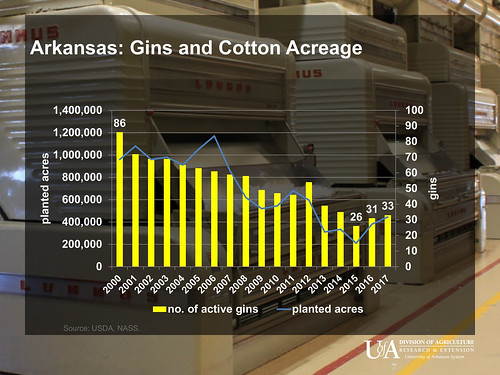As Arkansas cotton acres rebound, so do gin numbers
June 19, 2018
By Mary Hightower
U of A System Division of Agriculture
Fast Facts
- NASS: 33 active gins in Arkansas in 2017, up 2 from previous year
- Ginned bales rose 31 percent from 2016
(300 words)
(Newsrooms - With graphs available for download here: https://flic.kr/s/aHsmk1pWXZ)
Download Word version
LITTLE ROCK – The number of active cotton gins in Arkansas rose to 33 in 2017, paralleling an increase in cotton acres, according to statistics from the National Agricultural Statistics Service.
“With a recovery in cotton acres the last couple of years, Arkansas is also seeing some gins come back to life,” said Scott Stiles, extension economist for the University of Arkansas System Division of Agriculture. “In 2017 we saw two more gins operate than in 2016, one each in Craighead and Lee counties.”

Arkansas farmers planted 445,000 acres of cotton in 2017, up from 380,000 in 2016. Cotton acres have been in slow decline since 2000, with the exception of 2006, when growers planted 1.17 million acres.
Stiles also said the NASS numbers pegged another increase: “The trend toward much larger and higher volume gins is certainly continuing. A gin is definitely a massive investment in equipment that requires a lot of volume to make the numbers work.”
Of the 33 operating gins in 2017, 23 of them ginned 20,000 bales or more. In 2016, only 17 gins handled the same volumes.
Craighead and Mississippi counties had the largest number of working gins in 2017, each with seven. Ashley County had four, St. Francis had three, and Lee and Poinsett counties each had two. Clay, Chicot, Crittenden, Desha, Greene, Lincoln, Monroe and Philipps counties each had one.
However, low cottonseed prices may put the brakes on growth, Stiles said.
“We may find in 2018 that even increasing cotton acreage may not be enough to sustain gin numbers in the state,” he said.
“From discussions at our winter production meetings I did hear of at least one gin that did not plan to operate this fall,” Stiles said. “They cited low cotton seed prices as the reason. Earlier this year cotton seed prices fell to decade lows. Revenue from seed sales is the lifeblood for gins.”
Cottonseed prices spiked in June 2014 at $460 a ton and sank to $130 per ton in November 2017.
For more information about agricultural economics, contact your county extension office or visit www.uaex.uada.edu.
About the Division of Agriculture
The University of Arkansas System Division of Agriculture’s mission is to strengthen agriculture, communities, and families by connecting trusted research to the adoption of best practices. Through the Agricultural Experiment Station and the Cooperative Extension Service, the Division of Agriculture conducts research and extension work within the nation’s historic land grant education system.
The Division of Agriculture is one of 20 entities within the University of Arkansas System. It has offices in all 75 counties in Arkansas and faculty on five system campuses.
Pursuant to 7 CFR § 15.3, the University of Arkansas System Division of Agriculture offers all its Extension and Research programs and services (including employment) without regard to race, color, sex, national origin, religion, age, disability, marital or veteran status, genetic information, sexual preference, pregnancy or any other legally protected status, and is an equal opportunity institution.
# # #
Media Contact: Mary Hightower
Dir. of Communication Services
U of A System Division of Agriculture
Cooperative Extension Service
(501) 671-2126
mhightower@uada.edu